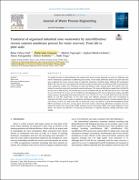Treatment of organized industrial zone wastewater by microfiltration/reverse osmosis membrane process for water recovery: from lab to pilot scale

View/
Date
2020-09-21Author
Ozbey-Unal, Bahar
Omwene, Philip Isaac
Yagcioglu, Meltem
Balcik-Canbolat, Çigdem
Karagunduz, Ahmet
Keskinler, Bulent
Dizge, Nadir
Metadata
Show full item recordAbstract
The global increase in industrialization has resulted into water scarcity. Research on water use efficiency and water reclamation is paramount in addressing this scarcity. In this study, laboratory and on-site pilot scale tests were conducted for water recovery from an industrial wastewater treatment plant. Different RO membranes (BW30, HP, and LE) were investigated with chemical treatment and ceramic microfiltration (MF) as pretreatment steps. Laboratory studies were conducted in dead-end filtration mode, whereas pilot scale studies were performed in cross flow mode with two spiral wound membranes. The removal efficiencies ranged from 40.0-86.3% for COD, 97.6- 99% for SO42-, 69.2-94.9% for Cr ion, 89.3-100% for Pb ion, 66.3-98.2 for Fe ion, 97.5- 99.7% for Zn ion, 95.1-99.5% for Si ion, and 79.1-100% for total phosphorus (TP). For the laboratory studies with 80% water recovery, the permeate flux reduced from 27.2 to 7.1 L/m2h, 35.7 to 1.3 L/m2h and 25.6 to 0.8 L/m2h for BW30, LE, and HP, respectively. On the other hand, four different operation modes were investigated to determine the effect of each mode on membrane performance and fouling properties. Average permeate flux of 18.7 and 21.3 L/m2h, 12.7 and 12.8 L/m2h, 13.4 and 14.6 L/m2h, 12.5 and 14.1 L/m2h were recorded for LE and BW30 membranes in the first, second, third, and fourth modes, respectively. Membrane autopsies were performed by atomic force microscopy (AFM), scanning electron microscopy (SEM), and energy dispersive X-rays (EDX). The system was effective in recovering the permeate to required industrial cooling and boiler water quality.
Collections
- Research Articles [28]
